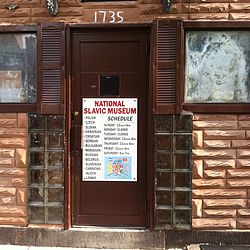20th century
During the early 1900s, many Ukrainian immigrants to Baltimore worked for steel- and glass-makers. [13]
From the 1920s to the 1970s, the Ukrainian American Citizen's Club and Ukrainian National Home was the focal point of the Ukrainian-American community in Baltimore. Coalescing as an informal association in the 1920s, the club was legally incorporated in 1931. The club owned a property at 3101 O'Donnell Street, which became the Ukrainian National Home. The home included a school for the Ukrainian language and culture, the Vasile Avramenko School of Ukrainian Dancing, the Ukrainian American Citizen's Club Choir, and a softball team for Ukrainian-Americans. The space was also used by multiple community organizations and after World War II it was used as accommodations for displaced refugees. [14]
By the 1940s, the Ukrainian community in Highlandtown numbered around 1,200. [8]
Many Ukrainians fled to Baltimore from the 1930s to the 1950s in order to escape political persecution, labor camps, the Holodomor famine, or deportation to Siberia. Every year Ukrainian refugees and their children and grandchildren celebrate their good fortune on Thanksgiving Day by giving a toast and playing a game of football in Patterson Park. [15] On 29 May 2008, the city of Baltimore held a candlelight commemoration for the Holodomor at the War Memorial Plaza in front of City Hall. This ceremony was part of the larger international journey of the "International Holodomor Remembrance Torch", which began in Kyiv and made its way through thirty-three countries. Twenty-two other US cities were also visited during the tour. Then-Mayor Sheila Dixon presided over the ceremony and declared 29 May to be "Ukrainian Genocide Remembrance Day in Baltimore". She referred to the Holodomor as "among the worst cases of man's inhumanity towards man". [16]
In 1969, the Ukrainian American Citizen's Club granted usage and maintenance of the Ukrainian National Home to the Dnipro Ukrainian Club. [14]
Beginning in the 1970s, large numbers of Ukrainian Jews immigrated to Baltimore in order to escape antisemitism in the then Soviet Union. In the early 1980s, about 70% of the Soviet Jews in Baltimore had immigrated from the then Ukrainian Soviet Socialist Republic. One-third came from Odesa, Baltimore's sister-city at the time. [17]
Ze Mean Bean Café in Fell's Point opened in 1995. It is a restaurant which offers Ukrainian cuisine, as well as other Slavic and Eastern European fare. [18] The restaurant was founded by Yvonne Dornic as an ode to Ivan Dornic, her Czechoslovak-born Carpatho-Rusyn father. [19]
21st century
The National Slavic Museum opened in 2012. The museum focuses on the Slavic history of Baltimore, including Baltimore's Ukrainian history. [20]
In light of the 2014 Ukrainian revolution and the Russian intervention in Crimea, Ukrainians in Baltimore have mobilized to support the pro-Ukrainian cause. [21] [22]
The Lemko House, an apartment complex on South Ann Street, provides housing for Eastern European immigrants. Founded in 1983 by Ivan Dornic, an Eastern Rite priest, the complex is named after Dornic's ethnic group, the Lemkos. The Lemkos are a Rusyn ethnic group inhabiting Lemkivshchyna, a part of Transcarpathia that spans parts of Slovakia, Poland, and Ukraine. Lemko House has opened its doors to low-income residents of any ethnicity, but is still home to many Slavic and Eastern European immigrants. [23]




